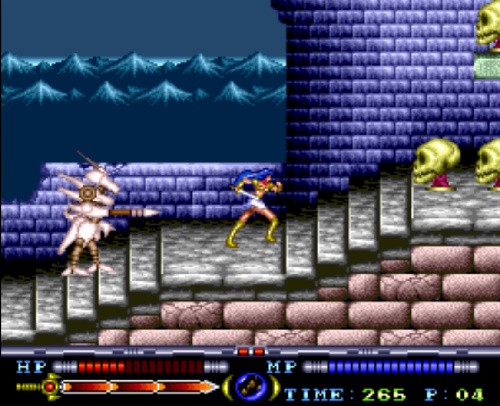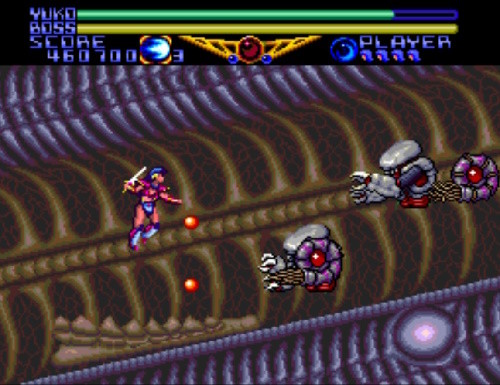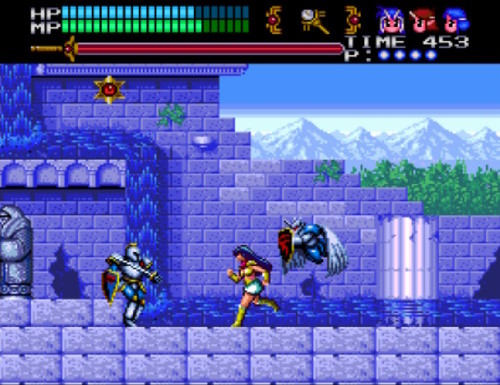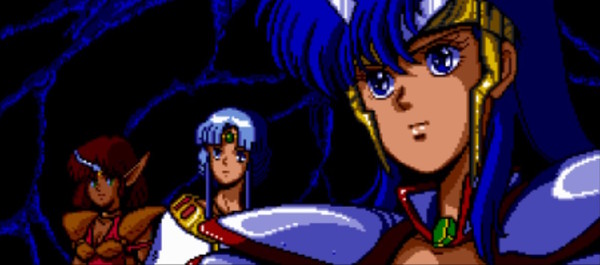Valis: The Fantasm Soldier Collection Volume 1 Game Review – Game Review

What place does the Valis series have in the history of video games? Well, it didn’t create a new field or become a worldwide phenomenon, but in 1986, the original Valis: The Fantasm Soldier indeed blazed a trail for games that sold themselves chiefly with anime-styled heroines. That may not grant the Valis line a permanent fixture at the Smithsonian, and yet Valis certainly captures the trends of an era in its side-scrolling action titles. The first volume of Valis: The Fantasm Soldier Collection may be the best place to appreciate that.
© Edia Co., Ltd.
Of course, to appreciate the Valis games one must also appreciate the mid-to-late 1980s anime market and its appetite for short OVA series. These direct-to-video attractions often barraged viewers with minimal plots, visual overkill, and heroines who needed little clothing. One might cruelly argue that this was an aesthetic better served by the immediate gratification of video games, and that’s where Valis entered. Taking undisguised cues from Leda: The Fantastic Adventures of Yoko and similar OVAs, Valis: The Fantasm Soldier embraced a world of alternate dimensions, armored bikinis, and half-mechanized villains dressed in voluminous capes as well as pauldrons the size of aircraft carriers.
Telenet Japan took Valis to many consoles and computers in the late 1980s and early 1990s, but the short of it is that the definitive versions of the first three games arrived in CD-ROM format on the PC Engine (aka the TurboGrafx-16 or the TurboDuo). Valis: The Fantasm Soldier Collection wisely leads with these.
VALIS: THE FANTASM SOLDIER
For those initial games Valis is all about Yuko, one of those seemingly ordinary teenagers with the weight of the world dropped on her shoulders. That world is Vecanti, a mystical realm where warlords, sorcerers, and demigods savagely vie for power. Yuko’s friend Reiko is somehow caught up in this, kicking off an odyssey where Yuko’s also transported to Vecanti and given the mystical sword of Valis and not a lot of armor to go with it.
The early versions of the first game, Valis: The Fantasm Soldier, were rough going, but this collection presents the PC Engine remake of the original Valis. Released in 1992 and developed by Telenet’s team Riot, it’s a reasonably solid side-scroller that follows Yuko from city streets to the more mystical depths of Vecanti. She gains a variety of projectile attacks for her sword while she fends off creatures in a fairly typical fashion. Her most notable move is a slide that can actually propel her across gaps and into empty space. No, it doesn’t make sense, but it allows her to avoid pits and reach items in ways more plausible action-game protagonists never could.

© Edia Co., Ltd.
Valis: The Fantasm Soldier is sharp in appearances for a 1992 game, as its CD format allowed some decent animation as well as a catchy, layered soundtrack. The cutscenes are lavish, extensively voiced (with Sumi Shimamoto as Yuko), and made with that clear pixel style that aged so much nicer than the digitized video clips of the 1990s. They’re also very much in the vein of suggestive OVAs, and that includes a gratuitous dressing sequence for Yuko. Even during gameplay, her skirt flies up whenever she jumps or takes damage. Really now, Telenet and/or Riot.
If the Valis: The Fantasm Soldier remake is competent, it’s also deep into old-fashioned difficulty. There’s a good variety of enemies, yet they swarm Yuko easily, and only by slow memorization can you really make progress. Boss battles are brutal, especially if Yuko’s sword and weapons aren’t fully powered up. That’s where this collection’s save states and rewind feature come in handy, and even then, it’s a challenge. And not the fair, compelling sort of challenge.
VALIS II
Valis II is a shakeup if you’re tackling these games in numbered order. It directly follows the first Valis, as Yuko returns to Vecanti to face down Emperor Megas and some revelations about her parentage. However, Valis II is the oldest game in this collection, hailing from 1990.

© Edia Co., Ltd.
As such, Valis II is cruder all around. Yuko has a decent arsenal of weapons, but the controls are somewhat stiff, and her animation is more limited (for those keeping track, however, neither Valis II nor III is as risque as the original). The stages rely on repetition, and the game turns into a complete chore as Yuko plunges into hellish caverns and fights one robotic dragon and green blob after another. Once again, the save states and rewind function are almost mandatory to preserve your weapons and any sense of enjoyment.
Despite those dips into tedium, Valis II at least embodies that reckless collision of ideas common to action games from this era. Vecanti seems to be a fantasy world, but it also hosts robots, mutants, and whatever else the developers thought looked cool. Streets and temples soon become caves with bizarre pulsating walls, futuristic laboratories full of genetic experiments and conveyor belts, or a final stage where Yuko hops on a giant jawbone and rides it up the absurdly long spine of an alien skeleton. It nicely cements the idea that Yuko is in a distinctly alien world where you can’t be sure what’s around the corner.
Valis II tells its tale in cutscenes that are more severely bordered than the later games, though at least it’s available in English or Japanese. The localization is the original NEC work from 1990, so it’s rough but charming in the manner of melodramatic old dubs. It’s especially amusing when characters call Yuko’s weapon “The Sword of Varris.” Maybe someone in legal was worried about the estate of Philip K. Dick and his Vast Active Living Intelligence System.
VALIS III
The third Valis game is one best known in the West, though that’s largely due to the Sega Genesis version. The PC Engine edition presented here is more elaborate, pulling Yuko back into a conflict and giving her two playable allies: whip-wielder Char (“Cham” in the Genesis release) and sorceress-princess Valna.

© Edia Co., Ltd.
The multi-character dynamic gives Valis III the most interesting gameplay of the trilogy, as the stages require picking the appropriate character or power-up. Instead of the general slashing and jumping of the earlier games, Valis III demands some low-level strategy, whether it’s freezing creatures as stepping stones or using Valna’s multi-hit spells to strike above. True, much of the challenge once again comes from the almost lazy profusion of enemies, as though the game just piled them on without regard for pacing or structure.
Detailed cutscenes unveil a story that’s slightly more complicated than previous games, though the despot Ramses (“Glames” in the Genesis version) is a simpler sort of jerkwad villain. The English voice acting is also astounding. If Valis II had slightly awkward performances, Valis III has thoroughly absurd and stilted readings of frequently bizarre dialogue. It’s sure to delight fans of ancient anime dubs.
Even if Valis III sports the most complex mechanics here, it still shows that this is a series just above average. At best Valis makes for mildly enjoyable side-scrollers, but they’re mostly unremarkable when it comes to their controls or stage design. That’s evident today, and it was perhaps evident decades ago. Even in the early 1990s the Valis titles were outclassed, as other developers built more than decent games around anime heroines. Valis never had the quick pace and weird gangster-Lovecraft setting of El Viento, the unique mechanics and complex stages of Alisia Dragoon, or the playful humor and invention of Trouble Shooter/Battle Mania. Being a genre pioneer isn’t everything.
So is Valis just shallow courting of a bygone era’s anime consumers, the type who bought expensive OVA laser discs just for the shower scenes? Not entirely. Valis II and III offer only marginal pandering, often quaint or unobtrusive by the standards of their day (Renovation even advertised the Genesis versions to a female demographic). If Yuko isn’t a particularly interesting heroine, she’s at least a sympathetic one, and you can easily cast subtext into her quest to save Reiko from the extra-dimensional equivalent of a creepy older boyfriend—or into her subsequent battles against male tyrants who threaten the apparently matriarchal peace of Vecanti.

© Edia Co., Ltd.
This brings us to that inevitable discussion of what’s NOT on this first volume of Valis: The Fantasm Soldier Collection. Valis IV, which introduced a new heroine, is notably absent in its PC Engine CD and inferior Super NES versions, but that’s only because Edia portioned out the various titles across three volumes. You’ll have to pick up the other two if you want Valis IV or the original Valis MSX game, the Famicom port, the other PC versions, and the Sega Genesis outings that include the super-deformed Syd of Valis. Overall, the selection excludes only some cell phone games and the pornographic (but fully licensed) Valis X titles. The less said about that, the better.
All three volumes are available on the Switch, though only the first is on Steam, and at this writing the original Valis: The Fantasm Soldier‘s cutscenes seem to have subtitles only in Story Viewer mode. Each game is sold separately, and even the soundtrack and art book cost extra, though the latter at least goes beyond the norm by translating a few Japanese magazine articles about the early Valis titles.
The first volume of Valis: The Fantasm Soldier Collection offers the series at its best. Yet it requires a true fondness for its era—or at least for the entire action-heroine genre of side-scrollers that Valis helped kick off. Detached from that, the games are sometimes enjoyable but too often undercut by simple design and repetitive challenges. Even so, Valis has its place in history. It may never make it into a museum, but this collection does it justice.
Source link
#Valis #Fantasm #Soldier #Collection #Volume #Game #Review #Game #Review



